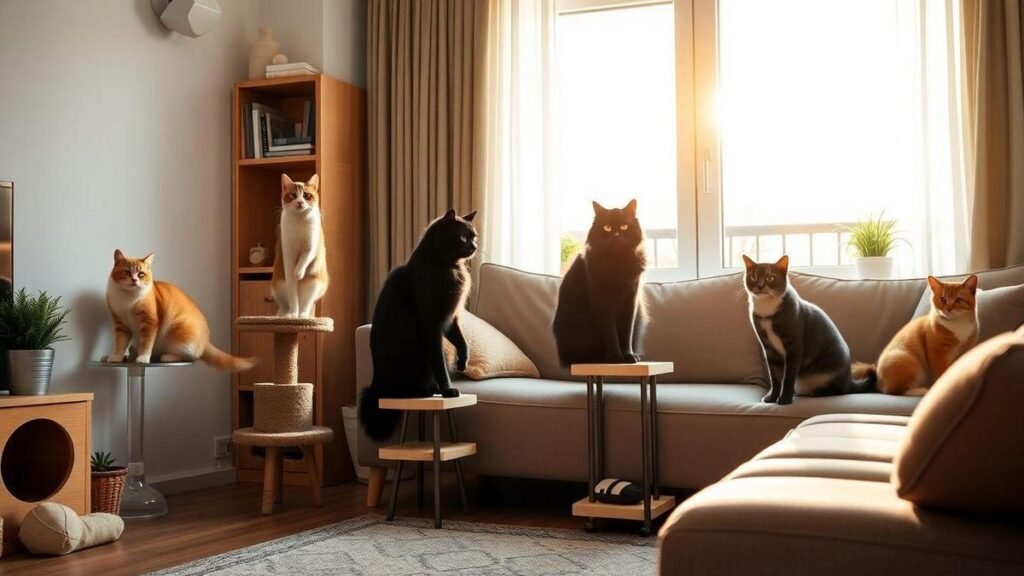Como escolher o melhor gato para apartamento — How I choose the best cat for an apartment
I know how stressful it can be to pick the right cat for a small home. Below I share how I choose calm, low-energy breeds I trust — like British Shorthair, Ragdoll, and Russian Blue — plus a quick checklist for energy, play needs, and noise. I cover short play sessions, the best toys, allergy-safe picks like Siberian and Balinese, and a simple cleaning checklist to cut allergens. I also explain litter and scratching rules, stress-reduction tips, my calming setup, and space-saving layout ideas so we both live happily together.
Key Takeaway
- I pick a calm cat that fits my small space.
- I prioritize low-energy breeds I can manage.
- I confirm litter training and good health.
- I check my lease and budget for food and vet care.
- I spend time with the cat to make sure we bond.
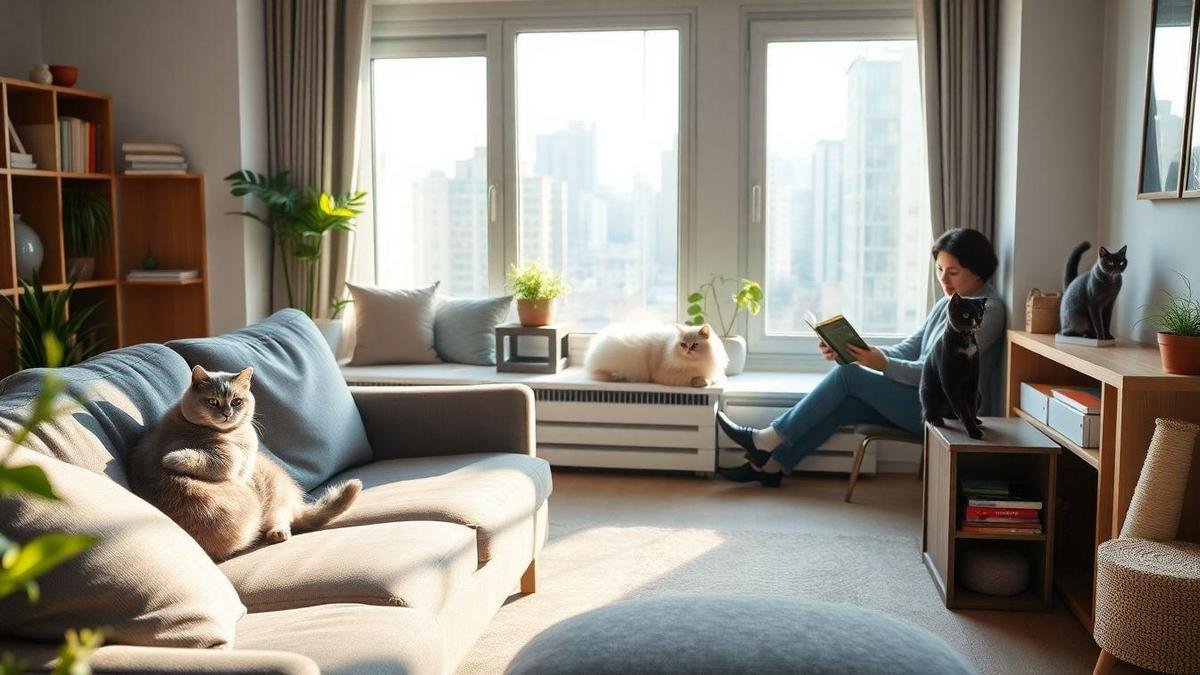
How I pick apartment-friendly cats (Como escolher o melhor gato para apartamento)
I live in a small flat and learned not every cat suits tight spaces. I ask one question first: will this cat feel calm here? That filter guides me when thinking, “Como escolher o melhor gato para apartamento.” I look for calm behavior, low energy, and a cat happy on laps and windowsills.
Why calm, low-energy cats work best
Calm cats handle limited space better: they scratch less, cry less at night, and use a smaller area to play. That saves stress.
Important traits I look for:
- Sleeps a lot — sleep equals peace.
- No need for hours of running.
- Enjoys proximity to people without demanding constant activity.
When a cat fits these points, my flat feels like home again.
Breeds I trust for apartments: British Shorthair, Ragdoll, Russian Blue
I chose these breeds after foster stays and visits. Each proved patient in a small home and matched my schedule and space.
| Breed | Temperament | Energy Level | Grooming | Why I like it |
|---|---|---|---|---|
| British Shorthair | Calm, steady | Low | Low | Quiet nature; sits and purrs without fuss |
| Ragdoll | Affectionate, gentle | Low–Medium | Medium | Goes limp in my arms; great for lap time |
| Russian Blue | Reserved, loyal | Low | Low | Smart, bonds with one person; adapts well to small spaces |
Quick checklist I use when choosing a breed for my apartment
- Energy level: pick low energy first.
- Noise: avoid breeds that meow a lot.
- Sociability: chooses cats that handle alone time.
- Grooming: lower grooming saves time.
- Health: prefer breeds with fewer breed-specific issues.
- Size: big cats can be fine — balance size with space.
- Play needs: short, frequent play sessions beat long workouts.
I test these by spending a few hours with a cat before committing. If it feels calm on day one, that’s a good sign.
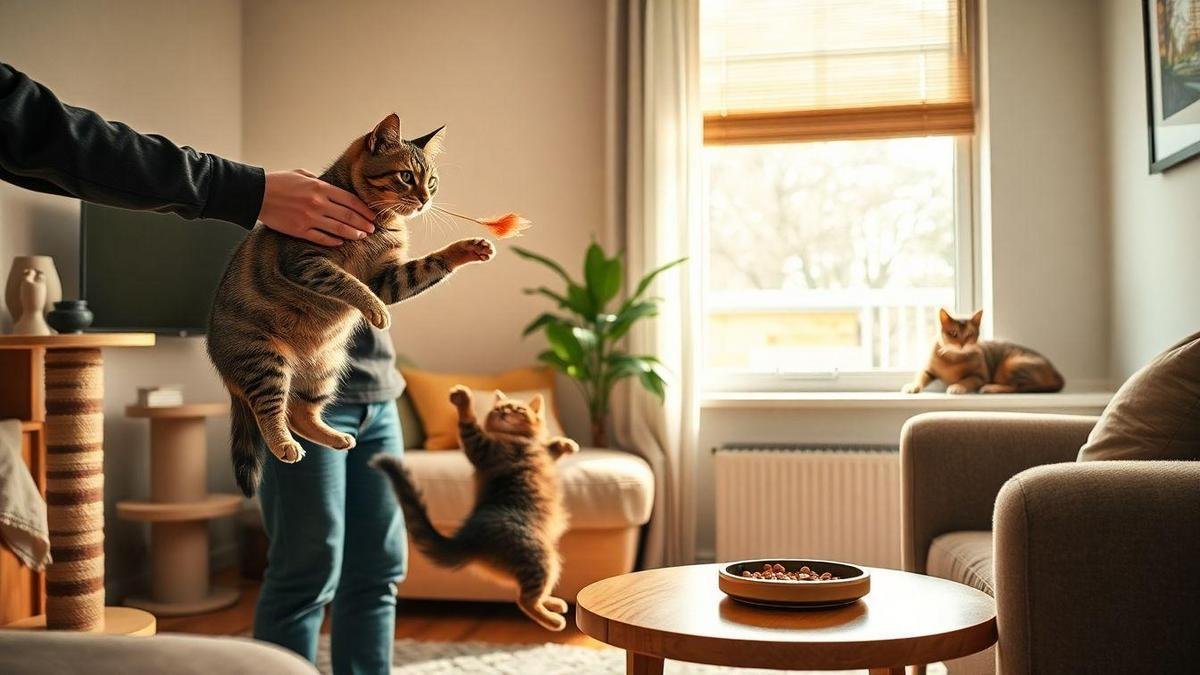
How I assess energy and play needs before adoption
Signs of a low-energy cat
- Lots of napping and slow movements.
- Greets softly or stays in one spot.
- Mild reaction to toys — prefers short, gentle play.
- Older cats and some breeds are often calmer.
| Sign | What it tells me |
|---|---|
| Sleeps a lot | Gentle activity needs |
| Moves slowly | Prefers low-impact play |
| Quiet with visitors | Handles apartment life |
| Mild reaction to toys | Short, gentle play works best |
Short play sessions and toys for small spaces
I keep play short and frequent: 5–10 minutes, 2–4 times a day. For ideas on toys that encourage short, stimulating play I use curated lists of the best indoor cat toys to keep your feline mentally stimulated. To add variety without taking space, I also build simple enrichment items like DIY cat tunnels using household items and rotate them weekly.
Toys and feeders that work well:
- Wand toy: invites short bursts of chase.
- Puzzle feeder: mental work without more room.
- Soft ball: gentle batting for low-energy cats.
- Cat bed on a shelf: safe lookout and rest spot.
I rotate toys weekly. Patience often wins — shy cats warm up after three short sessions over a couple of days.
My daily routine:
- Morning: 5 minutes gentle wand play.
- Midday: puzzle feeder or hidden treat, ~10 minutes.
- Evening: two short sessions (5–8 minutes each).
- Night: calm petting and brushing to wind down.
For preventing boredom when indoor-only, I follow strategies from guides on how to prevent indoor cats from getting bored.
How I handle allergies and choose hypoallergenic cats (Como escolher o melhor gato para apartamento)
I have allergies but still wanted a cat. I met breeders, visited shelters, and tested pets before deciding. Meeting cats for short visits and noting reactions helped me answer “Como escolher o melhor gato para apartamento” with confidence.
Breeds often easier for allergy sufferers
| Breed | Why fewer allergens | Apartment fit | Grooming notes |
|---|---|---|---|
| Siberian | Often reported lower Fel d 1 levels | Calm indoors; adapts well | Weekly brushing reduces loose fur |
| Balinese | Lower allergen production despite long hair | Quiet and affectionate | Regular grooming and combing |
| Russian Blue | Dense coat that spreads less dander | Likes routine | Brush once a week |
| Sphynx | Little fur to trap dander | Loves indoor warmth | Weekly baths to remove oils |
| Devon Rex | Short, curly coat that sheds less | Active but fits small spaces | Gentle wiping and occasional bath |
Cleaning habits to reduce allergens
Small space means every step matters:
- Vacuum with a HEPA filter twice a week.
- Use a high-quality air purifier in main rooms.
- Wash hands after petting.
- Limit cat on pillows.
- Prefer hard floors or low-pile rugs.
Litter box tips:
- Scoop daily to cut smell and dust.
- Choose dust-free, low-tracking litter.
- Place the box in a ventilated corner or balcony if allowed.
- Clean the box weekly with hot water.
- Use covered boxes only if the cat accepts them.
For persistent litter issues, I follow guidance on how to prevent litter box avoidance with simple tweaks.
My cleaning checklist:
- Daily: Scoop litter; wipe cat sleeping surfaces; wash hands.
- Every 3 days: Quick HEPA vacuum of main areas.
- Weekly: Wash cat bedding; clean litter box; check air purifier filter.
- Monthly: Deep clean floors and curtains; wash throws.
- As needed: Bathe or wipe cat (if breed allows); brush outside when possible.
These habits lowered my symptoms and made cuddling more comfortable. I also keep feeding and water areas tidy following tips on keeping your pet’s food and water area clean and safe, and I take precautions during chores with guidance from how to keep pets safe during cleaning and chores.
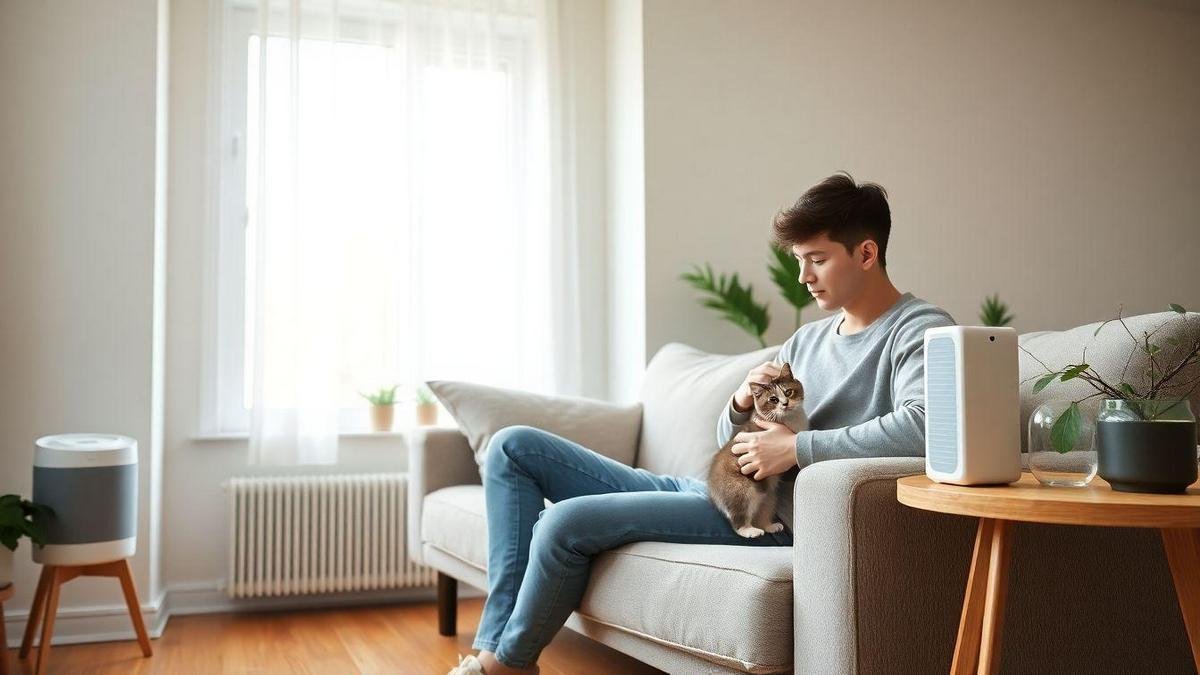
Managing indoor behavior in a tight space
I learned “Como escolher o melhor gato para apartamento” before adopting. Smart choices and steady habits make life smoother for both of us.
Litter box and scratching rules
- Place litter boxes in quiet, easy-to-reach spots.
- Use the same litter the cat knows; change slowly if switching.
- Clean the box daily.
- Offer multiple scratching options: sisal posts, horizontal boards.
- Reward good behavior with treats and praise.
For shaping good habits and preventing avoidance I rely on the practical steps in how to prevent litter box avoidance with simple tweaks.
| Rule | What I do | Why it works |
|---|---|---|
| Litter location | Low-traffic spots, away from loud machines | Privacy increases use |
| Box type | Wide, low-entry for older cats; covered for shy cats | Comfort → consistent use |
| Scratching outlet | Post near favorite nap spots | Redirects scratching from furniture |
| Positive reward | Treats and soft praise | Builds habit faster than punishment |
I never punish — punishment makes cats scared and hides problems. I fix causes instead.
Reducing stress and preventing unwanted behaviors
Watch for stress signs: hiding, over-grooming, or sudden litter changes. I act quickly and calmly.
- Keep a daily routine for feeding and play.
- Short, focused play sessions at least twice daily.
- Add vertical space (shelves, perches) so the cat can climb. To build these cheaply I used instructions from how to build a cat wall and learned to train them with how to train cats to use indoor climbing shelves.
- Minimize loud noises and provide a safe spot with a comfy bed.
- Use pheromone diffusers after big changes and review signs of stress in signs of separation anxiety in cats and how to help.
Small habits prevent big problems. Regular play cut down my cat’s night zoomies.
My calming setup:
| Item | Purpose |
|---|---|
| Cat shelf near window | Sunlight and lookout — I followed guides to build a perch without drilling in some rentals: how to build a cat window perch without drilling |
| Covered bed in quiet corner | Safe retreat |
| Interactive feeder | Slows eating, adds mental work |
| Sisal scratching posts | Protects furniture, meets instincts |
I rotate toys weekly and move slowly when she’s tense to build trust. For extra calm, I sometimes use music to help settle indoor cats, based on ideas from how to use music to calm indoor cats.
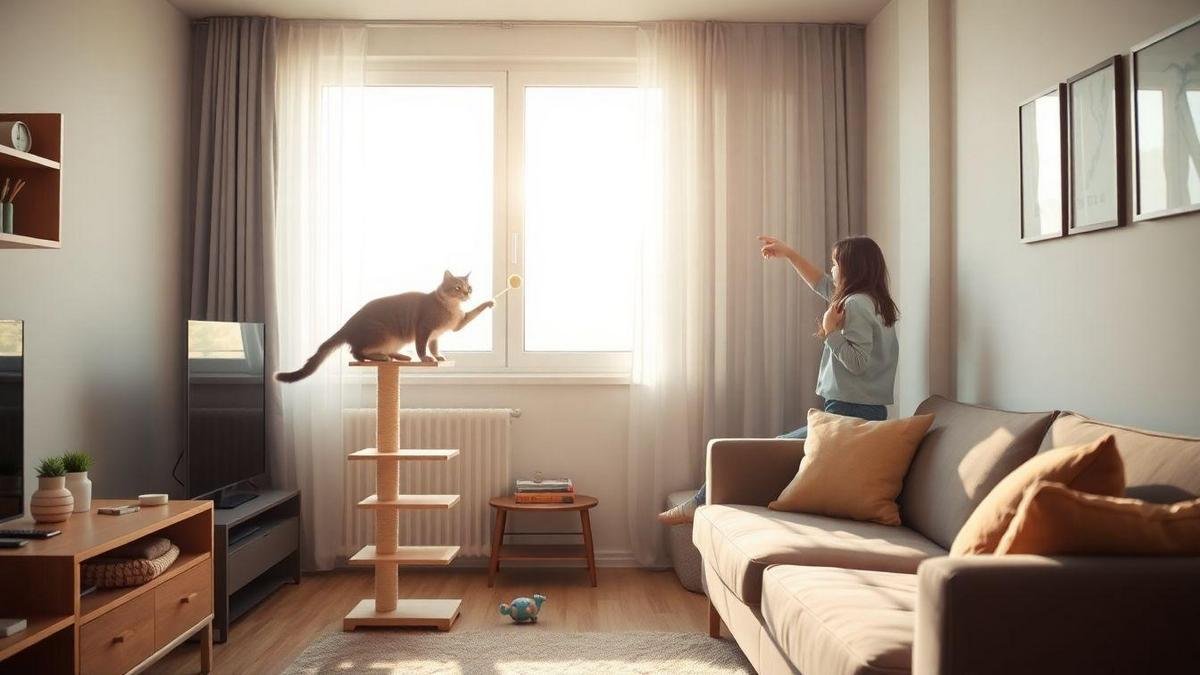
Quiet breeds and testing vocalization (Como escolher o melhor gato para apartamento)
Quiet is important in small flats. When asking “Como escolher o melhor gato para apartamento,” I look for low vocalization, calm temperaments, and matched energy.
Often quieter breeds: Chartreux, British Shorthair, Russian Blue
| Breed | Typical Noise Level | Temperament | Apartment Fit |
|---|---|---|---|
| Chartreux | Low | Calm, affectionate | Great |
| British Shorthair | Low | Easygoing, steady | Great |
| Russian Blue | Low–Moderate | Gentle, shy | Good |
How to test a cat’s noise level before adoption
A 30-minute test tells you a lot:
- Sit quietly with the cat for 10–15 minutes. Note unprovoked vocalization.
- Step out for 5 minutes, call softly from the door. Observe the reaction.
- Play 5 minutes, then stop. See if the cat yowls for more.
- Ask staff about nighttime behavior.
I once left the room with a shy Russian Blue; it gave one soft meow — a great sign for apartment life. For newly adopted cats, support guides like how to support a recently adopted rescue cat indoors and how to help a cat adjust to a new apartment are useful to ease the transition.
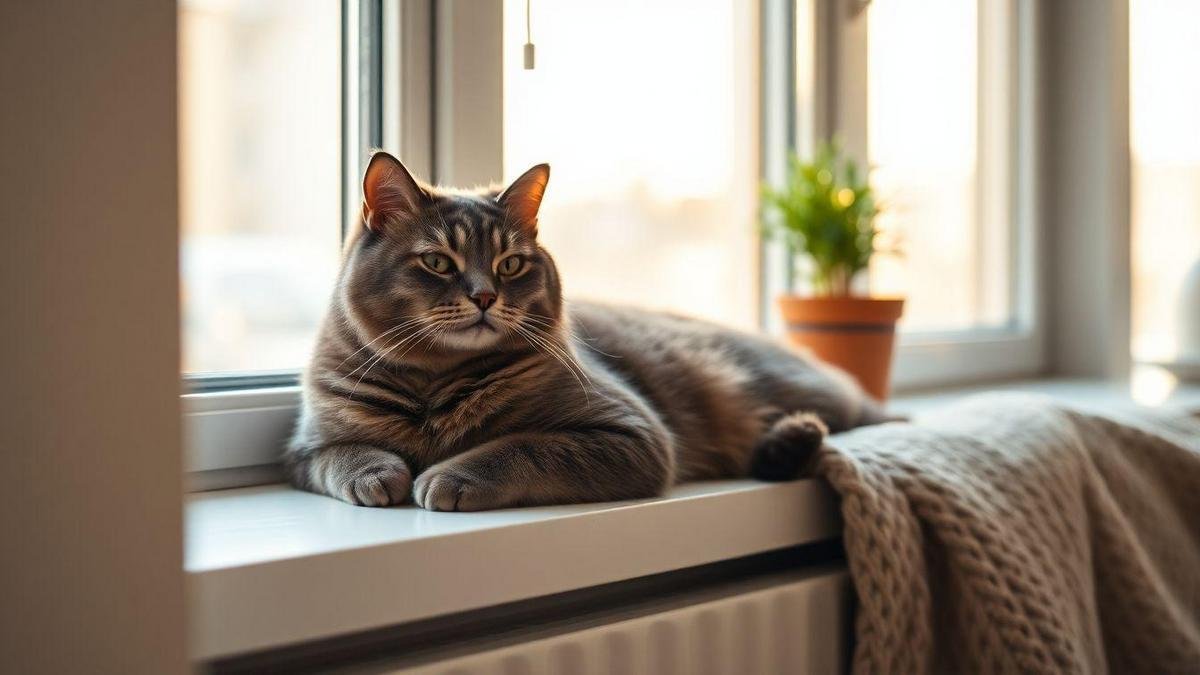
Litter and space optimization in a small flat
I learned how to keep clean air, a happy cat, and a small space working together. If you wonder “Como escolher o melhor gato para apartamento,” pick a calm breed and plan your space.
Litter box types and best spots
| Litter box type | Space used | Best spot | Why I like it |
|---|---|---|---|
| Covered box | Small footprint | Closet or under desk | Hides odor and looks tidy |
| Top-entry box | Small–medium | Corner or wardrobe shelf | Keeps litter in, reduces tracking |
| Drawer-style box | Compact | Cabinet with cut-out door | Hidden, blends with furniture |
| Self-cleaning box | Medium | Away from sitting areas | Cuts scooping time, reduces odor |
| Open low box | Tiny | Next to bed or sofa | Easy for older cats, fits narrow gaps |
Rule: leave one more box than cats (one cat = two boxes). Scoop daily and deep clean weekly to keep smell low. For building multiuse furniture that hides litter, see ideas in the vertical space and DIY resources below.
Vertical and compact furniture ideas
I built up, not out. Vertical space is gold:
- Wall shelves at cat height save floor space. I followed step-by-step plans for a cat wall in how to build a cat wall.
- Tall cat trees with small bases offer climbing with little footprint.
- Multi-use furniture (bench with hidden litter drawer) looks neat.
- Window perches keep the cat happy and save room — you can build a secure perch without drilling in many rentals: how to build a cat window perch without drilling.
- Slim scratching posts fit behind doors.
| Purpose | Item I use | Floor space saved |
|---|---|---|
| Climb/play | Wall-mounted shelves | High |
| Resting | Window perch | Medium |
| Litter hide | Bench with drawer | Medium |
| Scratch | Slim post | Small |
Step-by-step room layout for a small flat
- Map the room: doors, windows, outlets.
- Pick a quiet corner for the main litter box; keep near a plug if self-cleaning.
- Place a second litter box farther away.
- Add vertical path: shelves from window to a high bed.
- Set a cozy bed near the window.
- Keep food/water away from litter.
- Slim scratching post by the sofa.
- Test layout for a week; move one item if avoided.
Small moves had big impact — the room went from clutter to calm quickly. For balcony or exterior perches, I researched safe options in how to build a cat-safe balcony or window perch.

Final checklist — Como escolher o melhor gato para apartamento
- Match the cat’s energy to your schedule.
- Prefer calm, low-energy, and low-vocalization breeds.
- Spend time with the cat before adopting — run the 30-minute noise test.
- Have one more litter box than cats and scoop daily.
- Use vertical space and slim furniture to save floor area.
- Maintain a cleaning routine (HEPA vacuum, air purifier) to reduce allergens.
- Plan short, frequent play sessions and rotate toys for enrichment.
- Trust behavior more than labels; test the match in person.
For moving in and getting the cat settled I followed checklists like how to prepare your home for a new pet and practical transition steps in how to help your pet adjust to a new indoor environment.
Repeat to remember: Como escolher o melhor gato para apartamento — pick a cat whose energy matches your life, prioritize calm and comfort, and give patience time to build a bond.
Conclusion
Choosing a cat for a small apartment can feel like threading a needle. Look for calm, low-energy cats that fit your rhythm and rooms. I recommend breeds like British Shorthair, Ragdoll, and Russian Blue, but behavior proof matters most. Use the quick checklist, test the cat in person, and create a calm environment with smart litter, vertical space, and a steady cleaning routine. If it fits, it will fit like a glove.
For more comfort items I use a few trusted pieces — including the right cat bed — and practical how-tos on safe indoor setups.
Want more practical tips and stories? Read more at https://blogcraelo.com.
Frequently Asked Questions
Q: Which cat breeds fit best in small apartments?
A: I pick calm, low-energy breeds: British Shorthair, Ragdoll, and Russian Blue often adapt well.
Q: How do I match a cat’s energy to my daily life?
A: Check your schedule. Choose a cat with similar play needs. Avoid high-energy cats if you’re often out.
Q: What home setup keeps an apartment cat happy?
A: Tall scratch post, cozy window perch, clean litter boxes, rotated toys, and a quiet hideaway.
Q: Should I adopt an adult cat or a kitten for apartment living?
A: Adults are often calmer and easier to read. Kittens need more play and training.
Q: Where can I learn more about Como escolher o melhor gato para apartamento?
A: Read guides, talk to shelters and vets, and meet cats before deciding. Start with practical transition resources like how to help a cat adjust to a new apartment and how to support a recently adopted rescue cat indoors.

